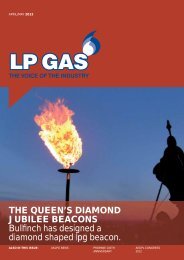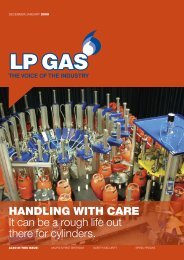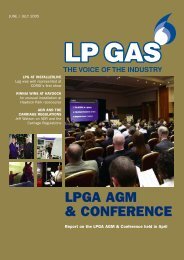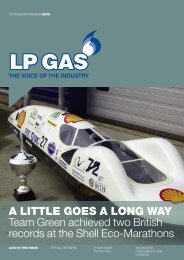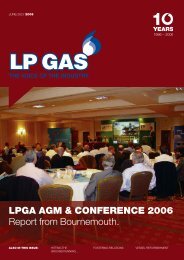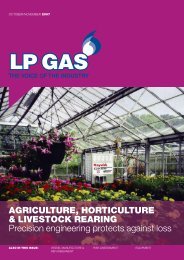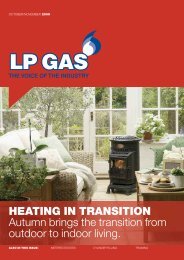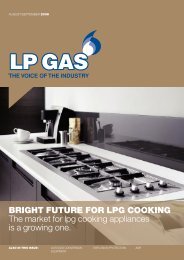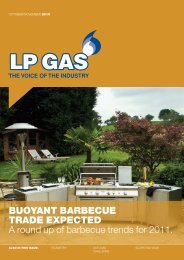C2572 02 Apr-May 06 AW - LP Gas Magazine
C2572 02 Apr-May 06 AW - LP Gas Magazine
C2572 02 Apr-May 06 AW - LP Gas Magazine
Create successful ePaper yourself
Turn your PDF publications into a flip-book with our unique Google optimized e-Paper software.
AUTOGAS CONVERSION EQUIPMENT<br />
Vintage Fiat 508cc 935 with Tartarini cng conversion, circa 1939.<br />
LONG, LONG AGO…<br />
by Nikki Key, operations manager, Autogas 2000 Ltd<br />
I wasn't quite sure where to start<br />
when Faye Spiers rang and asked<br />
me to compile a little piece for this<br />
issue. "Some technical information<br />
on lpg autogas conversions and how<br />
they work?" she suggested.<br />
Well, all of you engineers out there<br />
will know that's about as easy as<br />
estimating the dimensions of that<br />
infamous piece of string!<br />
Not being technical but having at<br />
hand some of the UK's most<br />
experienced time-served conversion<br />
engineers, it was agreed that a<br />
simple synopsis of the past and<br />
present conversion systems would<br />
be my motif.<br />
It may come as a surprise to many<br />
but it all began way back in the late<br />
1930s when shortages of petrol led<br />
to some innovative experimentation.<br />
The earliest conversions utilised the<br />
captured gaseous emissions from<br />
burning coal in a large bag, invariably<br />
carried on the roof of the vehicle.<br />
Fond memories of a classic Dad's<br />
Army episode spring to mind!<br />
This was soon followed with early<br />
lpg and cng being introduced into the<br />
carburettor of a conventional petrol<br />
engine by means of a<br />
vaporiser/regulator and venturi<br />
system. Tartarini Auto, one of Europe's<br />
leading system manufacturers, has<br />
been producing conversion<br />
components for over 60 years and the<br />
earliest lpg and cng systems involved<br />
carrying the lpg pressure cylinders on<br />
the roof of the vehicle in order to<br />
provide some range. Provision for<br />
refuelling was sparse, to say the least.<br />
Over the following years, several<br />
Italian companies persevered with<br />
the technology in Europe, followed<br />
keenly by the Dutch, and the first<br />
commercially available lpg systems<br />
went onto the Italian market in 1966.<br />
As petrol engines have advanced in<br />
their complexity, so too have the<br />
conversion systems to provide<br />
satisfactory dual fuel options.<br />
The introduction of closed loop<br />
catalytic controlled engines posed<br />
some complex problems, particularly in<br />
convincing the petrol engine<br />
management systems that all was well<br />
when emission signatures would<br />
suggest otherwise (lpg emitting cleaner<br />
tailpipe emissions than petrol). Through<br />
intensive r&d, these problems were<br />
overcome with emulation and product<br />
development and, throughout the mid<br />
to late 1990s, this formed the basis of<br />
standard conversions. However,<br />
nothing stands still, and greater<br />
requirement for improved tailpipe<br />
emissions on Euro 3 and 4 engines<br />
demand ever more efficient conversion<br />
systems and fuel strategies.<br />
The recent introduction of full<br />
sequential gas injection systems that<br />
utilise sophisticated injector units<br />
with slave ECU technology has been<br />
greatly appreciated by installers and<br />
customers alike, providing more<br />
efficient lpg operation, further<br />
improving emissions and fuel<br />
efficiency. The average cost of<br />
converting a petrol vehicle has, in<br />
real terms, decreased dramatically<br />
over the years as greater numbers of<br />
vehicles are converted.<br />
System reliability is much<br />
improved and, with the introduction<br />
of the <strong>LP</strong>GA Approved Installers<br />
Scheme, customers can be assured<br />
of quality and safety from over 200<br />
retrofit conversion companies<br />
throughout the UK. These installers<br />
now provide over 95% of<br />
conversions since the withdrawal of<br />
most of the vehicle manufacturer<br />
options and, in many cases, a full<br />
vehicle warranty is provided.<br />
The UK government recognises<br />
the advantages of using lpg as an<br />
automotive fuel and has adjusted the<br />
duty levels accordingly over<br />
successive years in order to promote<br />
uptake. Grants have also been<br />
available and Transport for London,<br />
recognising the advantages to local<br />
air quality, include many lpg vehicles<br />
in the exemption listing for<br />
congestion charges.<br />
The pressure on system<br />
manufacturers increases in the quest<br />
to further improve emissions and to<br />
ensure that lpg maintains its place at<br />
the forefront of viable alternatives to<br />
petrol and diesel. Security of supply of<br />
traditional fuels is more frequently in our<br />
headlines and more and more<br />
customers are taking a closer look at<br />
the lpg/autogas options that can satisfy<br />
the market on grounds of supply in<br />
harmony with the environment.<br />
Contact Autogas 2000 Ltd on<br />
01845 523213<br />
www.autogas.co.uk<br />
16<br />
<strong>LP</strong> GAS MAGAZINE APRIL/MAY 20<strong>06</strong>




